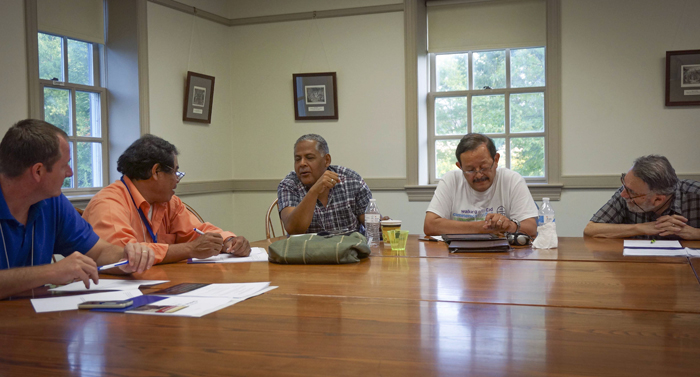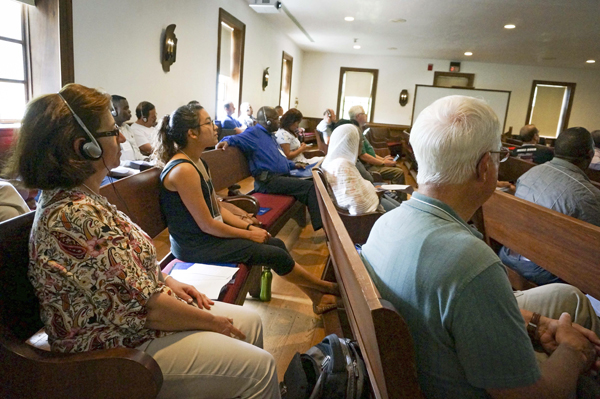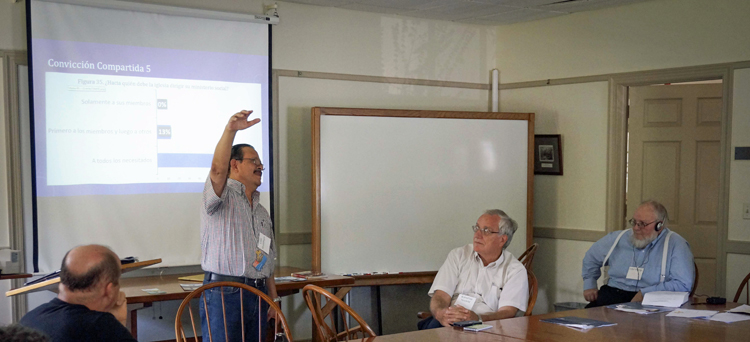Posted: September 17, 2015
Global Anabaptist Profile surveys and maps Mennonite World Conference
GOSHEN, Indiana, USA — Sociological surveys may be uncommon evangelistic tools, but at a consultation celebrating the conclusion of the Global Anabaptist Project (GAP), Damien Pelende testified that the survey had drawn new people into his church. The GAP, a joint initiative of the Institute for the Study of Global Anabaptism (ISGA-Goshen College) and Mennonite World Conference (MWC), is a two-year project profiling the demographics, beliefs and practices of 24 church conferences in MWC.
Pelende, a research associate who implemented the GAP survey in the Communauté des Églises de Frères Mennonites au Congo (DR Congo Mennonite Brethren), said, as news of the survey spread, curious bystanders showed up for the worship service. In one setting, more than 20 onlookers committed themselves to Christ; another time, a Catholic visitor, after reviewing the survey, decided to become a Mennonite.
At the consultation, hosted by the Young Center for Anabaptist and Pietist Studies at Elizabethtown (Pennsylvania) College, 26–30 July 2015, research associates and church leaders from 21 MWC member churches, representing 18 different countries analyzed the data and shared stories that gave crucial context to the numbers.
The consultation was the culmination of two years of data collection led by ISGA director John D. Roth and Conrad Kanagy, professor of sociology at Elizabethtown College.
In 2013, the group met at Goshen College in Indiana, USA, to determine the final content of the survey, structured around the MWC’s “Shared Convictions,” and to receive training in methods of survey implementation.
The survey was translated into 26 languages. Research associates implemented the survey with randomly-selected congregations of their respective national conferences. Kanagy processed and formatted the data prior to the consultation.
Ground-breaking church profile
The scope of the project is unprecedented for an ecclesial body, involving national church conferences from Paraguay to Ethiopia to the Philippines to Canada.
Funded and directed by the ISGA, the GAP is the first systematic attempt to gather quantitative data about Anabaptist groups affiliated with MWC, whose membership has more than tripled in the past three decades.
“Demographic data has been based largely on estimates,” wrote Roth in a report to research associates. “And we know even less about the theological convictions, worship practices, ethical commitments and forms of witness of many specific Anabaptist-Mennonite groups.”
Although the process of interpreting the survey results has only begun, the data collected from the groups who have completed the survey paints a complex picture of what MWC member churches hold in common and the ways in which they differ from one another.
Consultation contextualizes survey results
Presentations from research associates at the consultation were crucial for giving context to the survey data. “The research associates are the real experts in recognizing the authentic meaning of the results in their churches,” Kanagy said.
The results from some conferences, for example, suggested strong opposition to political involvement, which many research associates explained as a reaction to the corruption in their political systems.
Marcos Orozco of Convención de Iglesias Evangélicas Menonitas de Nicaragua (Evangelical Mennonite Conference) referenced his church’s experience during the Sandinista War to explain why CIEMN’s results reflected such a strong opposition to military service. “We recognized that we would be killing other brothers in the church,” Orozco said. “We were clear that we couldn’t do this.”
Consultation participants noted interesting differences in practices and assumptions regarding the gifts of the Holy Spirit, attitudes toward tithing, understandings of church agencies, views on evangelism and the role of women in church leadership.
Research associates reflect on challenges
The consultation also provided a forum for research associates to share challenges. Delbert Erb from Iglesia Evangélica Menonita Argentina collected data from participating churches across a distance of 2,000 kilometers (1,243 miles). In DR Congo and the Philippines, access to some of the most rural and remote congregations necessitated mountain travel and fording rivers.
The written format of the survey was challenging in contexts with higher rates of illiteracy. “By the time they hear all the options, they say they don’t know,” said Jethro Dube of the Brethren in Christ Church in Zimbabwe.
A number of research associates found a lower response rate among women – who are more likely than men to be illiterate. “We know that there are more women [in our churches] than men,” said Pelende, “but they are underrepresented in the survey.”
Profile suggests unity despite differences
Although the data has not yet been thoroughly analyzed, conversation at the consultation suggested the results will be significant for congregations, national conferences and global church bodies alike.
“This helps us see our needs, especially in areas of teaching,” said Reynaldo Vallecillo from Amor Viviente in Honduras.
In general, greater commonalities were found among churches of the Global South (Latin America, Asia, and Africa) and among the Global North (North America and Europe) than between those two groupings.
Regina Mondez of the Integrated Mennonite Churches of the Philippines said, “Despite different languages and cultures, the numbers communicate [a unity] across culture in ways that words could not.”
Roth and Kanagy are still awaiting data from two additional church conferences. When the data is complete, they will release a summary of the aggregate results and regional comparisons. The full data will also be made available to the MWC Executive Committee.
“This project is only one step toward a richer understanding of who we are as a global fellowship and how our churches are putting the gospel into practice,” said Roth. “My prayer is that the Global Anabaptist Profile will enable us to speak more freely about our weaknesses, to share our gifts more boldly, and to inspire renewal in our Christian faith and life in whatever setting we are in.”
– Elizabeth Miller is administrative assistant for the Institute for the Study of Global Anabaptism
 .
.
Latin American regional caucus (photo provided) GAP consultation group members listen to a presentation
at Elizabethtown College (photo provided)

César Montenegro leads a meeting (photo provided)

Comments: